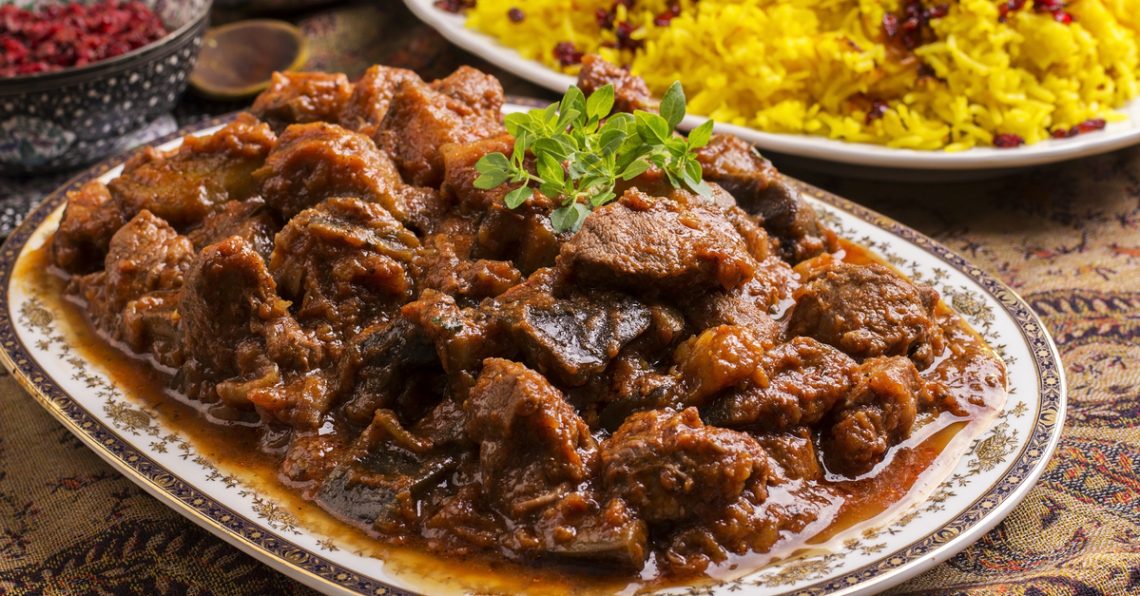
A Feast for the Eyes from Persia
Mediterranean cuisine is currently trendy for its healthy use of vegetables and meat. But the focus tends to be on Greece and Italy. Instead, I’ve been digging into the food of Persia – or Iran, as we know it today. Maybe I feel a kinship because its geography and climate have dictated its traditions, both for the good and the bad. After all, this is the area that perfected cereal grains like wheat. The mountains encircling Iran form a high plateau that is cold in winter and hot in the summer. Despite being arid, the melting snow from the mountains allows ample irrigation that Persians used to nurture their fields and orchards. Outside the mountain fringe, areas closer to the Persian Gulf are warm and produce a range of fruits and vegetables.
Exotic flavors from far-flung trade
And its location meant that it was a key part of the old Silk Road in North Persia and the Afro-Arab-Indian trade route in the south, making it a natural place to perfect foods and to incorporate ingredients from the trade. The Persians themselves carried spinach, pomegranates, saffron, and rosewater to the far corners of their empire, as well as to trading partners further afield. They also adopted produce from their colonies. Lemons, oranges, eggplant, and rice were brought from India and China.
The staple of the Persian diet is wheat, paired with lamb and poultry as well as yogurt and eggplant, not to mention a wide range of stuffed vegetables and sweet pastries. This is the cuisine built around slow-cooking pilafs, kebabs, and tagines. The Persian food vocabulary also includes biriani, garam masala, murgh, nan, and tikka. What I like most about it is its balance and visual appeal.
Vivid colors from fruits, vegetables, and herbs
Cookbook author Najmieh Batmanglij, considered the key expert on the region’s cuisine, notes in her book Food of Life that visual appeal is an important element. She writes, “Feasting our eyes is the first pleasure of a good meal.” Equally important is what she calls the delicate touch – “letafat” – that governs the art of Persian cuisine. In practice, that means finding a balance of sweet and sour, “hot,” and “cold.” Achieving this balance not only involves slow and careful preparation, but also a generous use of herbs and spices. Most meals are accompanied by fresh bread and a bowl of fresh herbs: tarragon, costmary (mint geranium), marjoram, lemon basil, mint, garlic chives, and radishes.
Delicious aromas from a slow-cooking pot
Because of the care and time involved, this cuisine is usually not for someone who is in a hurry and wants to rush a meal to a table. It’s ideal for a slow Sunday or a snowy day, when everyone is in the house to savor the delicious aromas as the meal slowly simmers away.
My experience with Persian cuisine so far includes a local fresh-caught haddock baked in yogurt with walnut and dill topping, and Iranian Noodle Soup. While we enjoyed the fish, the noodle soup made it into Mrs. Farmboy’s “Favorite Recipes” folio. I’m also going to try the pomegranate koresh with chicken, rice with green beans, chicken soup with chickpea and lamb meatballs, and the pistachio and pomegranate meatballs.
I’m wondering how I can bring these ideas of color, balance, and delicate flavors into the other dishes I’m making. How about you? Do you have a favorite dish from this region? What do you like best about it?
To comment, please click on “Read in Browser” or on the headline to view the blog on the website. You can log in and comment at the end of the blog to share your thoughts and start a discussion.
If you’d like to share the blog, click on the Facebook icon or one of the others. Thanks!





3 Comments
Susan R
Dawn is breaking and I want to start cooking these dishes immediately! They all sound great – and if the soup landed in Mrs. Farmboy’s favorites, that’s all I need to know – yumm!
Thank you for all the regional and historical connections – brings more senses to mind – and so many conplex spices and flavors.
I love dishes from this region – the use of fruits and nuts and yogurts – all often in one pot. I have only a couple “go to” recipes I rely on – I look forward to adding these to my collection. (although hard time considering haddock a Persian dish ingredient!)
Thank you!
Farmboy
To be fair, the original recipe calls for halibut, rock fish or catfish. I went with haddock, as that’s the whitefish that was on sale.
Nancy Crochiere
Interested in the haddock and yogurt recipe!